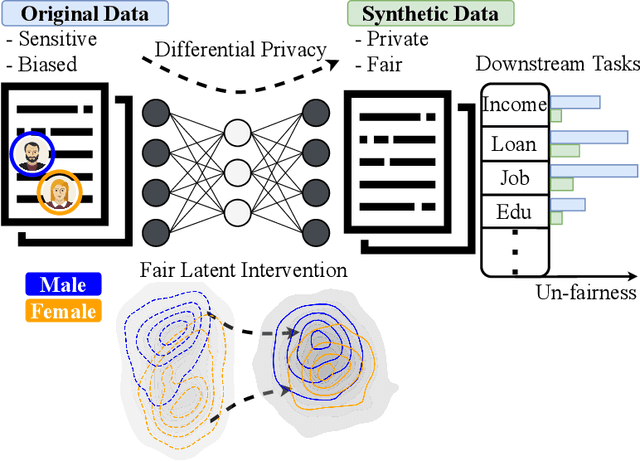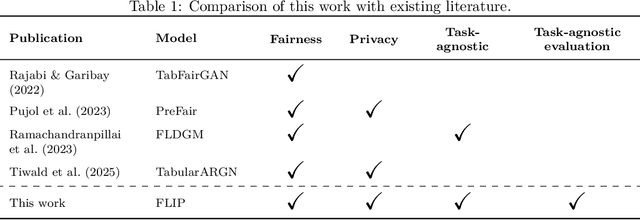Arthur Zimek
DCFO: Density-Based Counterfactuals for Outliers - Additional Material
Dec 18, 2025Abstract:Outlier detection identifies data points that significantly deviate from the majority of the data distribution. Explaining outliers is crucial for understanding the underlying factors that contribute to their detection, validating their significance, and identifying potential biases or errors. Effective explanations provide actionable insights, facilitating preventive measures to avoid similar outliers in the future. Counterfactual explanations clarify why specific data points are classified as outliers by identifying minimal changes required to alter their prediction. Although valuable, most existing counterfactual explanation methods overlook the unique challenges posed by outlier detection, and fail to target classical, widely adopted outlier detection algorithms. Local Outlier Factor (LOF) is one the most popular unsupervised outlier detection methods, quantifying outlierness through relative local density. Despite LOF's widespread use across diverse applications, it lacks interpretability. To address this limitation, we introduce Density-based Counterfactuals for Outliers (DCFO), a novel method specifically designed to generate counterfactual explanations for LOF. DCFO partitions the data space into regions where LOF behaves smoothly, enabling efficient gradient-based optimisation. Extensive experimental validation on 50 OpenML datasets demonstrates that DCFO consistently outperforms benchmarked competitors, offering superior proximity and validity of generated counterfactuals.
Achieving Hilbert-Schmidt Independence Under Rényi Differential Privacy for Fair and Private Data Generation
Aug 29, 2025



Abstract:As privacy regulations such as the GDPR and HIPAA and responsibility frameworks for artificial intelligence such as the AI Act gain traction, the ethical and responsible use of real-world data faces increasing constraints. Synthetic data generation has emerged as a promising solution to risk-aware data sharing and model development, particularly for tabular datasets that are foundational to sensitive domains such as healthcare. To address both privacy and fairness concerns in this setting, we propose FLIP (Fair Latent Intervention under Privacy guarantees), a transformer-based variational autoencoder augmented with latent diffusion to generate heterogeneous tabular data. Unlike the typical setup in fairness-aware data generation, we assume a task-agnostic setup, not reliant on a fixed, defined downstream task, thus offering broader applicability. To ensure privacy, FLIP employs R\'enyi differential privacy (RDP) constraints during training and addresses fairness in the input space with RDP-compatible balanced sampling that accounts for group-specific noise levels across multiple sampling rates. In the latent space, we promote fairness by aligning neuron activation patterns across protected groups using Centered Kernel Alignment (CKA), a similarity measure extending the Hilbert-Schmidt Independence Criterion (HSIC). This alignment encourages statistical independence between latent representations and the protected feature. Empirical results demonstrate that FLIP effectively provides significant fairness improvements for task-agnostic fairness and across diverse downstream tasks under differential privacy constraints.
Metrics for Inter-Dataset Similarity with Example Applications in Synthetic Data and Feature Selection Evaluation -- Extended Version
Jan 16, 2025



Abstract:Measuring inter-dataset similarity is an important task in machine learning and data mining with various use cases and applications. Existing methods for measuring inter-dataset similarity are computationally expensive, limited, or sensitive to different entities and non-trivial choices for parameters. They also lack a holistic perspective on the entire dataset. In this paper, we propose two novel metrics for measuring inter-dataset similarity. We discuss the mathematical foundation and the theoretical basis of our proposed metrics. We demonstrate the effectiveness of the proposed metrics by investigating two applications in the evaluation of synthetic data and in the evaluation of feature selection methods. The theoretical and empirical studies conducted in this paper illustrate the effectiveness of the proposed metrics.
Transparent Neighborhood Approximation for Text Classifier Explanation
Nov 25, 2024



Abstract:Recent literature highlights the critical role of neighborhood construction in deriving model-agnostic explanations, with a growing trend toward deploying generative models to improve synthetic instance quality, especially for explaining text classifiers. These approaches overcome the challenges in neighborhood construction posed by the unstructured nature of texts, thereby improving the quality of explanations. However, the deployed generators are usually implemented via neural networks and lack inherent explainability, sparking arguments over the transparency of the explanation process itself. To address this limitation while preserving neighborhood quality, this paper introduces a probability-based editing method as an alternative to black-box text generators. This approach generates neighboring texts by implementing manipulations based on in-text contexts. Substituting the generator-based construction process with recursive probability-based editing, the resultant explanation method, XPROB (explainer with probability-based editing), exhibits competitive performance according to the evaluation conducted on two real-world datasets. Additionally, XPROB's fully transparent and more controllable construction process leads to superior stability compared to the generator-based explainers.
Robust Statistical Scaling of Outlier Scores: Improving the Quality of Outlier Probabilities for Outliers (Extended Version)
Aug 30, 2024Abstract:Outlier detection algorithms typically assign an outlier score to each observation in a dataset, indicating the degree to which an observation is an outlier. However, these scores are often not comparable across algorithms and can be difficult for humans to interpret. Statistical scaling addresses this problem by transforming outlier scores into outlier probabilities without using ground-truth labels, thereby improving interpretability and comparability across algorithms. However, the quality of this transformation can be different for outliers and inliers. Missing outliers in scenarios where they are of particular interest - such as healthcare, finance, or engineering - can be costly or dangerous. Thus, ensuring good probabilities for outliers is essential. This paper argues that statistical scaling, as commonly used in the literature, does not produce equally good probabilities for outliers as for inliers. Therefore, we propose robust statistical scaling, which uses robust estimators to improve the probabilities for outliers. We evaluate several variants of our method against other outlier score transformations for real-world datasets and outlier detection algorithms, where it can improve the probabilities for outliers.
FSDEM: Feature Selection Dynamic Evaluation Metric
Aug 26, 2024Abstract:Expressive evaluation metrics are indispensable for informative experiments in all areas, and while several metrics are established in some areas, in others, such as feature selection, only indirect or otherwise limited evaluation metrics are found. In this paper, we propose a novel evaluation metric to address several problems of its predecessors and allow for flexible and reliable evaluation of feature selection algorithms. The proposed metric is a dynamic metric with two properties that can be used to evaluate both the performance and the stability of a feature selection algorithm. We conduct several empirical experiments to illustrate the use of the proposed metric in the successful evaluation of feature selection algorithms. We also provide a comparison and analysis to show the different aspects involved in the evaluation of the feature selection algorithms. The results indicate that the proposed metric is successful in carrying out the evaluation task for feature selection algorithms. This paper is an extended version of a paper accepted at SISAP 2024.
SynthEval: A Framework for Detailed Utility and Privacy Evaluation of Tabular Synthetic Data
Apr 24, 2024Abstract:With the growing demand for synthetic data to address contemporary issues in machine learning, such as data scarcity, data fairness, and data privacy, having robust tools for assessing the utility and potential privacy risks of such data becomes crucial. SynthEval, a novel open-source evaluation framework distinguishes itself from existing tools by treating categorical and numerical attributes with equal care, without assuming any special kind of preprocessing steps. This~makes it applicable to virtually any synthetic dataset of tabular records. Our tool leverages statistical and machine learning techniques to comprehensively evaluate synthetic data fidelity and privacy-preserving integrity. SynthEval integrates a wide selection of metrics that can be used independently or in highly customisable benchmark configurations, and can easily be extended with additional metrics. In this paper, we describe SynthEval and illustrate its versatility with examples. The framework facilitates better benchmarking and more consistent comparisons of model capabilities.
Dimensionality-Aware Outlier Detection: Theoretical and Experimental Analysis
Jan 10, 2024



Abstract:We present a nonparametric method for outlier detection that takes full account of local variations in intrinsic dimensionality within the dataset. Using the theory of Local Intrinsic Dimensionality (LID), our 'dimensionality-aware' outlier detection method, DAO, is derived as an estimator of an asymptotic local expected density ratio involving the query point and a close neighbor drawn at random. The dimensionality-aware behavior of DAO is due to its use of local estimation of LID values in a theoretically-justified way. Through comprehensive experimentation on more than 800 synthetic and real datasets, we show that DAO significantly outperforms three popular and important benchmark outlier detection methods: Local Outlier Factor (LOF), Simplified LOF, and kNN.
Sharing is CAIRing: Characterizing Principles and Assessing Properties of Universal Privacy Evaluation for Synthetic Tabular Data
Dec 19, 2023



Abstract:Data sharing is a necessity for innovative progress in many domains, especially in healthcare. However, the ability to share data is hindered by regulations protecting the privacy of natural persons. Synthetic tabular data provide a promising solution to address data sharing difficulties but does not inherently guarantee privacy. Still, there is a lack of agreement on appropriate methods for assessing the privacy-preserving capabilities of synthetic data, making it difficult to compare results across studies. To the best of our knowledge, this is the first work to identify properties that constitute good universal privacy evaluation metrics for synthetic tabular data. The goal of such metrics is to enable comparability across studies and to allow non-technical stakeholders to understand how privacy is protected. We identify four principles for the assessment of metrics: Comparability, Applicability, Interpretability, and Representativeness (CAIR). To quantify and rank the degree to which evaluation metrics conform to the CAIR principles, we design a rubric using a scale of 1-4. Each of the four properties is scored on four parameters, yielding 16 total dimensions. We study the applicability and usefulness of the CAIR principles and rubric by assessing a selection of metrics popular in other studies. The results provide granular insights into the strengths and weaknesses of existing metrics that not only rank the metrics but highlight areas of potential improvements. We expect that the CAIR principles will foster agreement among researchers and organizations on which universal privacy evaluation metrics are appropriate for synthetic tabular data.
Explaining text classifiers through progressive neighborhood approximation with realistic samples
Feb 11, 2023Abstract:The importance of neighborhood construction in local explanation methods has been already highlighted in the literature. And several attempts have been made to improve neighborhood quality for high-dimensional data, for example, texts, by adopting generative models. Although the generators produce more realistic samples, the intuitive sampling approaches in the existing solutions leave the latent space underexplored. To overcome this problem, our work, focusing on local model-agnostic explanations for text classifiers, proposes a progressive approximation approach that refines the neighborhood of a to-be-explained decision with a careful two-stage interpolation using counterfactuals as landmarks. We explicitly specify the two properties that should be satisfied by generative models, the reconstruction ability and the locality-preserving property, to guide the selection of generators for local explanation methods. Moreover, noticing the opacity of generative models during the study, we propose another method that implements progressive neighborhood approximation with probability-based editions as an alternative to the generator-based solution. The explanation results from both methods consist of word-level and instance-level explanations benefiting from the realistic neighborhood. Through exhaustive experiments, we qualitatively and quantitatively demonstrate the effectiveness of the two proposed methods.
 Add to Chrome
Add to Chrome Add to Firefox
Add to Firefox Add to Edge
Add to Edge